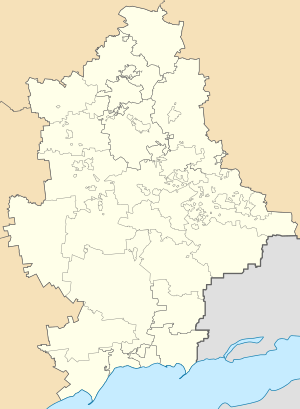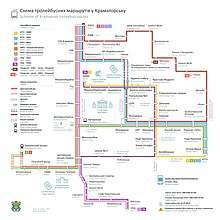Kramatorsk
Kramatorsk (Ukrainian: Краматорськ [krɐmɐˈtɔrʲsʲk]; Russian: Краматорск [krəmɐˈtorsk]) is a city of oblast significance located at the northern portion of Donetsk Oblast, in eastern Ukraine. Since October 11, 2014 Kramatorsk has been the provisional seat of Donetsk Oblast, following the events surrounding the War in Donbass.[1] Similar status, for Luhansk oblast, has Sievierodonetsk. Their previous cities are still de jure administrative centres.
Kramatorsk Краматорськ | |
|---|---|
 Flag  Coat of arms | |
 -2.jpg)   | |
 Kramatorsk Kramatorsk on the map of Donetsk Oblast  Kramatorsk Kramatorsk (Ukraine) | |
| Coordinates: 48°43′N 37°32′E | |
| Country | |
| Oblast | |
| Founded | 1868 |
| City status since | 1932 |
| Area | |
| • City | 117.1 km2 (45.2 sq mi) |
| Population (2013) | |
| • City | 164,283 |
| • Density | 583/km2 (1,510/sq mi) |
| • Metro | 197,752 |
| Time zone | UTC+2 (EET) |
| • Summer (DST) | UTC+3 (EEST) |
| Postal code | 84300-84390 |
| Area code(s) | +380 626(4) |
| Website | www |
The city is located on the banks of the Kazennyi Torets River which is a right tributary of the Siversky Donets. Its population is approximately 157,627 (2017 est.)[2]. It is an important industrial and mechanical engineering centre in Ukraine. At various periods, Kramatorsk was a place of residence for a number of notable people including Leonid Bykov, Joseph Kobzon, and Ruslan Ponomariov, the youngest person to ever become FIDE World Chess Champion.
Geography

Kramatorsk metro area is located between Sloviansk Raion and Kostiantynivka Raion making a central part of a major urban agglomeration with over 500.000 inhabitants.
Demographics
Kramatorsk has a population of over 164,700 inhabitants (2013) and has a metropolitan area of over 197,000 inhabitants (2013). As of the Ukrainian Census of 2001:[3]
According to the regional department of statistics, as of January 1, 2017, the population of Kramatorsk was 190,648 people.[4]
- Ethnicity
- Ukrainians: 70.2%
- Russians: 26.9%
- Belarusians: 0.7%
- Armenians: 0.6%
- Azerbaijanis: 0.2%
- Jews: 0.1%
- Language
- Russian: 67.9%
- Ukrainian: 31.1%
- Armenian: 0.2%
- Belarusian: 0.1%
- Romani: 0.1%
History
The city grew from a settlement by a small railway station in 1868 into a major urban settlement in the north of Donetsk Oblast with several heavy machine production facilities.
In April 1918 troops loyal to the Ukrainian People's Republic took control of Kramatorsk.[5]
It was occupied by Nazi Germany between 27 October 1941 and 5 February 1943 and again between 27 February 1943 and 6 September 1943.
Between 1980 and 1989, several people were exposed to a radiological source in one of the apartment buildings, resulting in 6 deaths and at least 17 cases of radiation sickness.
2014 clashes
On April 12, the police station in Kramatorsk was seized by (armed military dressed) pro-Russian militants, and later the city council.[6] This resulted in a tense standoff between the Ukrainian Armed Forces and pro-Russian militants. After months of fighting, the rebels withdrew and the city came under Ukrainian control on 5 July 2014.[7] Kramatorsk became provisional centre of Donetsk Oblast in 13 October 2014.
Economy and Industry
Kramatorsk has not stayed away from the international outsourcing trend prompted by the emergence of the information society in Ukraine in the Post-Soviet years. An IT company QuartSoft Corp. was founded in Kramatorsk in 1999. Now it has offices in the United States and Austria.
Machinebuilding
- New Kramatorsk Machinebuilding Plant (NKMZ), 1934 - design and production of machines and equipment for mining, steel rolling, metallurgy, production and handling of cast iron, artillery weapon systems.
- Old Kramatorsk Machinebuilding Plant,
In the 2000s, a wind turbine production facility was constructed in Kramatorsk. This is a joint venture between German Fuhrländer AG and its Ukrainian partners. According to their site, Fuhrländer became the first company in the renewable energy sector to obtain a building permit from the Ukrainian government.[8]
Transportation

Between 1937 and August 1, 2017, Kramatorsk had a tram network. However, it is now closed and public transportation is provided by buses and trolley-buses.[9]
Civil society
Notable people
- Natalia Veselnitskaya, (b. 1975) prominent Russian attorney during the Russian interference in the 2016 United States elections
References
- "Kikhtenko to move Donetsk administration to Kramatorsk and to leave power structures in Mariupol". Zerkalo Nedeli (in Russian). Retrieved 3 November 2014.
- "Чисельність наявного населення України (Actual population of Ukraine)" (in Ukrainian). State Statistics Service of Ukraine. Retrieved 26 August 2017.
- "Население Краматорска продолжает сокращаться" Donetskie Novosti, March 10, 2017
- (in Ukrainian) 100 years ago Bakhmut and the rest of Donbass liberated, Ukrayinska Pravda (18 April 2018)
- "Ukraine crisis: Kramatorsk police headquarters stormed". BBC. April 13, 2014. Retrieved July 7, 2014.
- "Separatists cleared from Sloviansk and Kramatorsk". Kyiv Post. July 7, 2014.
- "Fuhrländer opens joint venture park in Ukraine". Retrieved 2012-09-28.
- http://www.metro-report.com/news/news-by-region/europe/single-view/view/kramatorsk-tram-network-closes.html